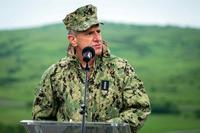Clarence E. "Bud" Anderson arrived in the European Theater of World War II in 1943, an experienced pilot at a time when many of his contemporaries had around an hour of experience in the cockpit. Anderson had been flying since 1941, when he was just 19 years old, and he brought that experience to the air war above occupied Europe. His aviation career would span four decades, earning him the coveted "triple ace" designation and a well-deserved place in the National Aviation Hall of Fame.
Anderson died in his sleep at his home in Auburn, California, on May 17, 2024, just a little over a year after the Air Force bestowed him with a post-retirement promotion to brigadier general. He was 102 years old.

Northern California was always home for Anderson. He was born in Oakland on Jan. 13, 1922, and attended high school in Auburn. When he turned 19, the United States had still not entered World War II, but he gained his pilot's license that year through the Civilian Pilot Training Program. After the attack on Pearl Harbor, he joined the Army Air Forces as an aviation cadet. Upon completion of fighter pilot training, he was sent to England with the 357th Fighter Group.
Then-Lt. Anderson would be trained to fly the P-39 Airacobra fighter, but the 357th would soon get a new weapon, the legendary P-51 Mustang. The pilots of the 357th would get little time to train with the P-51; as their commander famously told them, "You can learn to fly `51s on the way to the target."
This is where his experience counted the most. In his Mustang, nicknamed "Old Crow" for his favorite brand of bourbon, Anderson would fly 116 combat missions over two tours, logging some 480 hours and 16 air-to-air kills, usually while escorting bombers on their way to targets in Europe. To be named an "ace" required five confirmed combat kills.
Downing 16 enemy fighters not only made Anderson a "triple ace," it made him the highest scoring pilot in the 363rd Fighter Squadron. He had entered combat as a captain at age 22; by the time he returned home in 1945, he was a 23-year-old major.
"In the sky those damned Germans must've thought they were up against Frankenstein or the Wolfman," Chuck Yeager, the legendary pilot and fellow member of the 363rd, would later write of Anderson in his 1985 autobiography. "Andy would hammer them into the ground, dive with them into the damned grave, if necessary, to destroy them."
Anderson's career didn't end with World War II. After the war, he trained to become a test pilot, learning to fly the United States' earliest jet aircraft while pushing it to its limits. He also participated in experimental flying, testing fighters attached to the wingtips of bombers to increase their ranges. These so-called "parasite" planes, F-84 Thunderjet fighters mounted on B-36 bombers, could detach and reattach to their mother ship when needed. Over the course of his career, he flew more than 130 different aircraft, logging an astonishing 7,500 flying hours.

During the Vietnam War, Anderson was sent to Takhli Royal Thai Air Force Base, where he was not only commander of the 355th Tactical Fighter Wing and its complement of F-105 Thunderchiefs, he also flew missions against North Vietnamese supply lines. He oversaw the closure of the base when the 355th was deactivated in1970.
Anderson retired in 1972 as a colonel, earning two Legions of Merits, five Distinguished Flying Crosses, the Bronze Star, 16 Air Medals, the French Legion of Honor and the French Croix de Guerre over his 30-year military career.
Anderson didn't stop flying when he left the military; in fact, he didn't stop flying until he was 90 years old. After retiring from service, he became the manager of the McDonnell Aircraft Company's Flight Test Facility at Edwards Air Force Base, consulted on video games, wrote articles about aviation and gave regular lectures.
Anderson was inducted into the National Aviation Hall of Fame in 2008, received the Congressional Gold Medal in 2015 (along with the other World War II aces) and a promotion to brigadier general in 2022.
"[Bud's] kind of a wrecking ball of a guy and I think for many of us, probably wouldn't want to have him behind us shooting us down -- he had a distinguished career," Brown said during the ceremony. "It was really good to have a chance just to read through [some of Bud's service records] and for me personally to reflect on the impact you had on our history of our Air Force."
Want to Learn More About Military Life?
Whether you're thinking of joining the military, looking for post-military careers or keeping up with military life and benefits, Military.com has you covered. Subscribe to Military.com to have military news, updates and resources delivered directly to your inbox.















